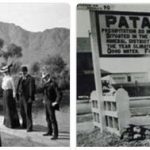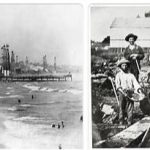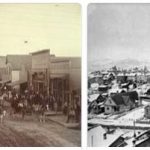HISTORY OF ILLINOIS
The retreating glaciers of the Ice Age certainly left their mark on large areas of Illinois, giving way to a landscape of rolling country and prairie, thus earning Illinois the nickname, “Prairie State.”
An advanced mound-building culture ( called the Mississippians) flourished in this area of North America from AD 800 to the mid-15th century. That civilization disappeared for unknown reasons.
In the early 16th century ( Illiniwek Confederation) a political union of local American Indian tribes was formed. The name Illiniwek later gave Illinois its name. Eventually the Pottawatomie, Miami and Sauk Indians also inhabited the area.
In 1673 French explorers Jacques Marquette and Louis Joliet began their exploration of the Illinois and Mississippi rivers . Others followed, and for much-needed protection from the local Indians, forts were built. The French claimed all this new land for their home country, and it became part of a vast piece of land across North America called New France. It remained part of the French Empire until the Treaty of Paris of 1763, when it passed to the victorious British in the French and Indian War (1754-1763). During the American Revolutionary War (1775-1783), approximately 2000 Native American hunters inhabited the area. In 1778 George Rogers Clark, an officer from
The Virginia colonies led American forces in Illinois to fight the British and claim land.
After the war, in 1783, this entire region ceded to the United States of Virginia and it became part of the Northwest Territory; land that would be settled, and eventually divided into separate states within the United States.
From the previously established Indiana Territory, the Illinois Territory was created on March 1, 1809 by an act of the US Congress. By 1810, settlers were pouring into the area, many arriving via river barges that traveled down the Ohio River.Subsequently, the southern part of the state developed first. Illinois became 21st US state in 1818 with his capital at Kaskaskia. In 1819 the capital was moved to Vandalia, and later to Springfield.
The Black Hawk War of 1832 resulted in all remaining Native American tribes driven west of the Mississippi River. The expansion of the railways in the 19th century facilitated the arrival of large numbers of immigrant farmers from Sweden and Germany.
Illinois Timeline
1600s
(1673) French explorers Jacques Marquette and Louis Jollit arrived in Illinois
(1675) Marquette founded a mission in the Great Village of Illinois
(1680) French merchants René Robert Cavelier, Sieur de La Salle and Henri de Tonti built Fort Crevecoeur on the Illinois River; Iroquois Indians destroyed Big Village
(1682) La Salle, Tonty built Fort St. Louis across the Illinois River from the Big Village site
(1699) Cahokia founded, oldest city in Illinois
1700s
(1717) Illinois part of the French Colony of Louisiana
(1720) Fort de Chartres became the seat of civilian, military government in Illinois
(1730) French troops, Indian allies in central Illinois massacred Fox Indians
(1754 – 1763) French Indian War
(1763) French Indian War ended, Illinois ceded to Great Britain in Treaty of Paris
(1769) Besieged Indians of Illinois, starved at Fort St. Louis (now Starved Rock)
(1778) George Rogers Clark defeated the British at Kaskaskia
(1787) Illinois became part of the Northwest Territory
1800s
(1800) Illinois incorporated into Indiana Territory
(1803) Kaskaskia Indians ceded nearly all of Illinois to the US; US Army erected Fort Dearborn
(1804) Lewis and Clark’s expedition started near
the Wooden River
(1809) Congress created Illinois Territory
(1811) First coal mine in Illinois opened in Jackson County; parts of southern Illinois damaged by New Madrid earthquake
(1812) Potawatomi Indians destroyed Fort Dearborn, massacred 52 troops and civilians
(1817) Veterans of the War of 1812 received 160-acre warrants of land in the Illinois War Treaty between the Illinois and Mississippi rivers
(1818) Illinois became the 21st American state, Kaskaskia, chosen as the capital
(1819) Kickapoo Indians displaced west of the Mississippi ceded most of their lands in central Illinois
(1820) Vandalia became state capital
(1823) Galena became a mining center of lead
(1824) Call of the constituent assembly to allow slavery defeated by the electors
(1829) Potawatomi, Ottawa, Chippewah Indians ceded lands in northern Illinois by agreement at Prairie du Chien
(1830) Abraham Lincoln moved to Illinois; first state prison built in Alton
(1837) Chicago incorporated as a city; a pro-slavery mob killed an abolitionist editor, Elijah P. Lovejoy in Alton; John Deere designed the self-scrolling steel plow
(1839) National Road ended from Cumberland, Maryland to Vandalia; Springfield became the state capital; Cherokee Indians passed through southern Illinois on the Trail of Tears
(1844) Mormon leaders, Joseph and Hyrum Smith, killed in Carthage by anti-Mormons
(1846) Mormons left Illinois for Utah
(1847) Cyrus Hall McCormick opened a plant in Chicago for manufacturing wheat harvesters
(1848) Chicago Mercantile Exchange organized; Illinois & Michigan Canal completed
(1853) Legislation enacted by the General Assembly to prevent free blacks from establishing in Illinois
(1855) Free public school system adopted
(1856) First railroad bridge across the Mississippi River completed between Davenport, Iowa and Rock Island
(1860) Abraham Lincoln chose the American President
(1861) Civil War has begun; Cairo became a detachment, a supply center for the Union Army
(1864) Lincoln re-elected US President
(1865) Illinois first states to ratify Thirteenth Amendment abolishing slavery; Lincoln killed in Washington DC buried in Springfield
(1867) George M. Pullman founded Pullman Palace Car Company in Chicago, manufactured railroad sleeping cars
(1868) Ulysses S. Grant chose the American President
(1871) Chicago Fire destroyed 18,000 downtown buildings, estimated damages of $200 million
(1883) First mandatory school attendance legislation enacted by the General Assembly; the world’s first skyscraper, the Home Insurance Building, designed in Chicago
(1886) Riot and bombing in Chicago at Haymarket Square during a labor rally
(1892) Mira Bradwell, Chicago attorney, first woman admitted to practice before the US Supreme Court; Adlai Stevenson I chose the US Vice President
(1893) World’s Fair held in Chicago
(1894) Attack the Pullman factory in Chicago became a national railroad strike; federal troops called in to control mob violence
(1898) United Miners win labor disputes after 11 miners, guard killed at Pana and Virden
(1890) Frank Lloyd Wright established a studio in Oak Park to design prairie-style architecture
1900s
- (1903) Iroquois Theater in Chicago destroyed by fire, nearly 600 killed
- (1906) Chicago White Sox defeated Chicago Cubs in the World Series
- (1908) Race riots held in Springfield
- (1909) National Association for the Advancement of Colored People (NAACP) formed after the Springfield riots; Cherry coal mine fire killed 259
- (1915) The steamboat that Eastland capsized in the Chicago River, 1812, died
- (1917) National Guard troops sent to East St. Louis to quell race riots; Chicago White Sox beat the New York Giants in the World Series
- (1918) Illinois influenza epidemic killed 32,000
- (1919) Chicago White Sox players charged with gambling at World Series; Chicago race riots left 38 dead, 500 injured, 1,000 residents left homeless
- (1921) Football team, Staleys moved from Decatur to Chicago, won national championship
- (1922) Mob violence, “Herrin Massacre”, at a quarry in Williamson County, killed three union miners, 20 strikebreakers; Staleys became Chicago Bears
- (1925) Charles Gates Dawes became US Vice President; 695 deaths in three states (including Illinois) caused by tornadoes
- (1926) Charles Lindbergh started the Daily Mail providing flight service between Chicago and Louis
- (1929) Chicago Valentine’s Day massacre – Alphonse Capone mobsters killed seven rival Chicago mobsters
- (1933) Chicago mayor, Anton J. Sermak, died during an assassination attempt on President-elect Franklin D. Roosevelt; first All-Star Baseball game held at Comiskey Park
- (1934) Chicago Black Hawks won the National Hockey League Championship (Stanley Cup)
- (1937) Shot by police, killed ten strikers at Republic Steel in Chicago
- (1949) Garden Place Airport renamed O’Hare Field in honor of Lieutenant Commander Edward O’Hare, killed in World War II
- (1954) Raymond Kroc opened the first McDonald’s fast food restaurant in Des Plaines
- (1955) Richard J. Daley elected to first six terms as Chicago mayor
- (1957) The world’s first nuclear power plant activated the Argonne National Laboratory
- (1958) Illinois toll road opened; fire at Our Lady of Angels School in Chicago kills 92 children, three nuns
- (1968) 650 arrests took place during civil unrest at the Democratic National Convention in Chicago
- (1970) Voters passed a new constitution
- (1972) Chicago Union Animal Farms closed; Abraham Lincoln Home in Springfield designated the first National Historic Landmark in Illinois; commuter trains collided in Chicago, 45 passengers killed, more than 200 injured
- (1974) Sears Tower, tallest building in the world, completed in Chicago; state lottery approved by the General Assembly
- (1979) Jane Byrne first female mayor of Chicago
- (1980) Ronald Reagan chose the American President
- (1983) Harold Washington elected Chicago’s first African-American mayor
- (1986) Chicago Bears win Super Bowl
- (1993) Flood in southern and western Illinois
- (1997) Field Museum of Natural History paid $8.4 million for Tyrannosaurus Rex fossil, Sue
- (1998) Run the destroyed historic Chicago Pullman railcar plant; Chicago Bulls win NBA Championship
2000s
- (2003) George Ryan switched death sentences for all 156 inmates on death row
- (2005) Abraham Lincoln Presidential Library and Museum opened; Chicago White Sox win World Series; The entire Children’s Health Insurance Bill has been approved
- (2006) FBI arrested seven people suspected of plotting to blow up the Sears Tower; American immigrants organized a boycott, over 400,000 participated in Chicago
- (2007) Illinois Senator Barack Obama announces bid for US President
- (2008) Barack Obama chose the American president; Gov. Rod Blagojevich, accused of trying to sell Barack Obama’s Senate seat
- (2009) Governor Rod Blagojevich impeached for abuse of power
- (2010) Chicago Blackhawks won the Stanley Cup
- (2010) Chicago Blackhawks won the Stanley Cup
- (2011) Ex-governor Rod Blagojevich, found guilty of corruption
- (2011) Former White House Chief of Staff, Rahm Emanuel, elected mayor of Chicago
- (2012) Former governor, Rod Blagojevich, began a 14-year prison sentence after being convicted of 18 counts of federal corruption








